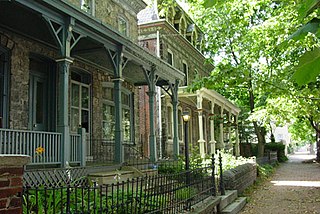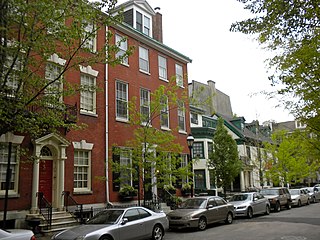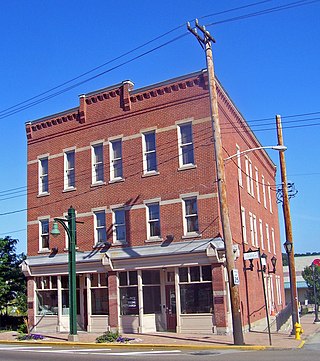
The Mother Bethel African Methodist Episcopal Church is an historic church and congregation which is located at 419 South 6th Street in Center City Philadelphia, Pennsylvania, USA. The congregation, founded in 1794, is the oldest African Methodist Episcopal congregation in the nation.

Powelton Village is a neighborhood of mostly Victorian, mostly twin homes in the West Philadelphia section of Philadelphia, Pennsylvania. It is a national historic district that is part of University City. Powelton Village extends north from Market Street to Spring Garden Street, east to 32nd Street, west to 40th and Spring Garden Streets, and to 44th and Market Streets.

John Wanamaker Department Store was one of the first department stores in the United States. Founded by John Wanamaker in Philadelphia, it was influential in the development of the retail industry including as the first store to use price tags. At its zenith in the early 20th century, Wanamaker's also had a store in New York City at Broadway and Ninth Street. Both employed extremely large staffs. By the end of the 20th century, there were 16 Wanamaker's outlets, but after years of change, the chain was bought by A. Alfred Taubman in late 1986, and added to his previous purchase of Woodward & Lothrop, the Washington, D.C., department store. In 1994, Woodies, as it was known, filed for bankruptcy. The assets of Woodies were purchased by the May Company Department Stores and JCPenney. In 1995, Wanamaker's transitioned to Hecht's, one of the May Company brands. In 2006, Macy's opened in the former Philadelphia Wanamaker's Department Store, now called Macy's Center City. The building is a National Historic Landmark. One if its expansions was designed by master architect Daniel Burnham. It contains the Wanamaker Organ, the largest functional organ in the world.

Washington Square West is a neighborhood in Center City, Philadelphia, Pennsylvania, United States. The neighborhood roughly corresponds to the area between 7th and Broad Streets and between Chestnut and South Streets, bordering on the Independence Mall tourist area directly northeast, Market East to the north, Old City and Society Hill to the East, Bella Vista directly south, Hawthorne to the southwest, and mid-town Philadelphia and Rittenhouse Square to the west. The area takes its name from Washington Square, a historic urban park in the northeastern corner of the neighborhood. In addition to being a desirable residential community, it is considered a hip, trendy neighborhood that offers a diverse array of shops, restaurants, and coffee houses. Washington Square West contains many gay-friendly establishments, especially in the gay village area of the neighborhood commonly known as the Gayborhood, which hosts annual events celebrating LGBT culture in Philadelphia, including OutFest.

Kensington is a neighborhood in Philadelphia that belongs to Lower Northeast. As with all neighborhoods in the city, the lack of any official designation means the boundaries of the area vary between sources over time and are disputed among locals. Kensington, as most long-term residents view it, refers generally to the area consisting of Kensington, East Kensington, West Kensington, and Harrowgate. The adjacent Fairhill and Norris Square neighborhoods are more separate but may be included in Kensington; Fishtown and South (Olde) Kensington were historically included. The most conservative boundaries of the neighborhood, shown in the map below, are Front Street and 5th Street to the west, the Amtrak train tracks to the North, Trenton Avenue, the Trenton Avenue train tracks, and Frankford Avenue to the east, and Cecil B. Moore Avenue to the south.

The University of Pennsylvania Campus Historic District is a historic district on the campus of the University of Pennsylvania, in Philadelphia, Pennsylvania, USA. The university relocated from Center City to West Philadelphia in the 1870s, and its oldest buildings date from that period. The Historic District was added to the National Register of Historic Places on December 28, 1978. Selected properties have been recorded by the Historic American Buildings Survey, as indicated in the table below.

Parkside is a neighborhood that is located in the West Philadelphia section of Philadelphia, Pennsylvania, United States.

The Philadelphia Quartermaster Depot, now known as the Defense Logistics Agency Troop Support, was founded as the Schuylkill Arsenal in 1799.

New Market, as it was originally known, and later also known as Head HouseMarket and Second Street Market, is an historic street market which is located on South 2nd Street between Pine and Lombard Streets in the Society Hill neighborhood of Philadelphia, Pennsylvania. With a history dating to 1745, it is one of the oldest surviving market buildings of its type in the nation.

The Bost Building, also known as Columbia Hotel, is located on East Eighth Avenue in Homestead, Pennsylvania, United States. Built just before the 1892 Homestead Strike, it was used as headquarters by the Amalgamated Association of Iron and Steel Workers and for reporters covering the confrontation. It is the only significant building associated with the strike that remains intact. It is a contributing property to the Homestead Historic District. It was declared a National Historic Landmark in 1999.

The Hill–Physick–Keith House, also known as the Hill–Keith–Physick House, the Hill–Physick House, or simply the Physick House, is a historic house museum located at 321 S. 4th Street in the Society Hill neighborhood of Philadelphia, Pennsylvania, USA. Built 1786, it was the home of Philip Syng Physick (1768–1837), who has been called "the father of American surgery". The house was declared a National Historic Landmark in 1976. It is now owned and operated by the Philadelphia Society for the Preservation of Landmarks as a house museum.

Historic RittenhouseTown, sometimes referred to as Rittenhouse Historic District, encompasses the remains of an early industrial community which was the site of the first paper mill in British North America. The mill was built in 1690 by William Rittenhouse and his son Nicholas on the north bank of Paper Mill Run near Philadelphia, Pennsylvania. The district, off Lincoln Drive near Wissahickon Avenue in Fairmount Park, includes six of up to forty-five original buildings. RittenhouseTown was listed on the National Register of Historic Places and was designated a National Historic Landmark District on April 27, 1992.

The Carl Mackley Houses, also originally known as Juniata Park Housing, is a private apartment complex in the Juniata neighborhood of Philadelphia, Pennsylvania. Built in 1933–1934 as single-family apartments, it opened in 1935. The project was sponsored by the American Federation of Full Fashioned Hosiery Workers, with financing by the Housing Division of the Public Works Administration, of which it was the first funded project. The complex was named for a striking hosiery worker killed by non-union workers during the H.C. Aberle Company strike in 1930.

The Brown Building is a ten-story building that is part of the campus of New York University (NYU), which owns it. It is located at 23–29 Washington Place, between Greene Street and Washington Square East in the Greenwich Village neighborhood of Manhattan, New York City, and is best known as the location of the Triangle Shirtwaist Factory fire of March 25 1911, which killed 146 people.

The Pennsylvania School for the Deaf is the third-oldest school of its kind in the United States. Its founder, David G. Seixas (1788–1864), was a Philadelphia crockery maker-dealer who became concerned with the plight of impoverished deaf children who he observed on the city's streets. The current school building is listed by the National Register of Historic Places, and two former campuses are similarly recognized.

This is a list of the National Register of Historic Places listings in Center City, Philadelphia.

The Oliver H. Bair Funeral Home is an historic, American building that is located in Philadelphia, Pennsylvania.

The Pitcairn Building, also known as the Pittsburgh Plate Glass Company Building, is an historic, American warehouse and light manufacturing loft building that is located at 1027 Arch Street at the corner of North 11th Street in the Chinatown neighborhood of Philadelphia, Pennsylvania.

Washington Avenue Historic District, or Washington Avenue Factory District, is a national historic district located in the Hawthorne and Bella Vista neighborhoods of South Philadelphia, Pennsylvania. It comprises the remaining four blocks of one of the last industrial neighborhoods in Philadelphia, and encompasses eight contributing buildings built between 1889 and 1927:
























